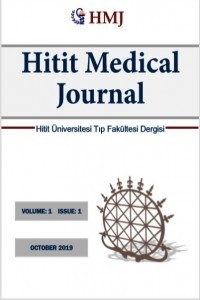Eritrosit sedimentasyon hızı 100mm/saat ve üzerinde olan hastalarda hastalık tanı dağılımı
Amaç: Hastanemizde eritrosit sedimentasyon hızının 100 mm/saat ve üzerinde olduğu saptanan hastalarda hastalık tanı dağılımını incelemeyi amaçladık. Gereç ve yöntem: Hitit Üniversitesi Tıp Fakültesi Eğitim Araştırma Hastanesi İç Hastalıkları Kliniği ve yandal bölümlerine 1 Ocak 2018-2020 tarihleri arasında başvuran hastalar retrospektif olarak incelendi. Eritrosit sedimentasyon hızın100 mm/saat ve üzerinde olan hastalar çalışmaya dahil edilerek bu hasta grubunda hastalık tanı dağılımı ve oranları belirlendi. Bulgular: Çalışmaya 203 hasta dahil edildi. .Bunlardan 108'i kadın (%53,2), 95’i (%46,8) erkekti. Ortalama yaş 67±13.4yıl olarak tespit edildi. Çalışmaya dahil edilen hastaların hastalık tanı dağılımlarına bakıldığında birinci sırada enfeksiyöz hastalıklar 77 (%37,92) yer alırken sırasıyla onkolojik 25 (%12,31), nefrolojik 41 (%20,19) ve romatolojik hastalık 13 (%6,39)tanılarının çoğunluğu teşkil ettiği görüldü Sonuç: Eritrosit sedimentasyon hızı enfeksiyöz, bağ doku hastalıkları ve malign hastalıklarda ilk basamaklarda yol gösterici bir tetkik olabilir.
Anahtar Kelimeler:
Enfeksiyon, Eritrosit sedimentasyon hızı
Diagnostic distributions in patients with erythrocyte sedimentation rate of 100 mm / hour
Objective:We aimed to investigate the diagnosis of disease distribution in patients with an erythrocyte sedimentation rate of 100 mm/hour and above. Materials and methods: Patients who applied to the Internal Medicine Service of Hitit University Education and Research Hospital and its minor departments between January 1, 2018 and January 1, 2020 were retrospectively analyzed. Patients with erythrocyte sedimentation rate of 100 mm/hour and above were included in the study, and the diagnosis and distribution of the disease were determined in this patient group. Results: 203 patients were included in the study. Of these, 108 were women (53.2%) and 95 (46.8%) were men. The average age was 67±13.4 years. When the disease diagnosis distribution of the patients included in the study is examined, infectious diseases were 77 (37.9%), while oncological 25 (12.3%), nephrological 41 (20.2%) and rheumatological disease 13 (6.4%) constituted the majority Conclusion: Erythrocyte sedimentation rate may be a guiding test in the first step of infectious, connective tissue diseases and malignant diseases.
Keywords:
erytocyte sedimentation rate,
___
- Kaynaklar 1. Reinhart WH. Erythrocyte sedimentation rate-More than an old fashion? Ther Umsch 2006;63:08-119.
- 2. Piva E, Sanzari MC, Servidio G, Plebani M. Length of reaction in undiluted blood (erythrocyte sedimentationrate): variations with sex and age and reference limits. Clin Chem Lab Med 2001;39:451-454.
- 3. Saadeh C. The erythrocyte sedimentation rate: old and new clinical applications. South Med J 1998;91:220-224.
- 4. Bridgen M. The erythrocyte sedimentation rate. Still a helpful test when used judiciously. Postgrad Med 1998;103:272-275.
- 5. Dinç A. Sedimentasyon yüksekliðine yaklaşım. In: Koçar IH, Erikçi S, Baykal Y. İç Hastalıklarında Karar Verme. Ankara: GATA Basımevi, 2002:483-484.
- 6. Çam H, Özkan HÇ. Eritrosit sedimentasyon hızı. Türk Pediatri Arşivi 2002; 37: 194-200.
- 7. Bedell SE, Bush BT. Erythrocyte sedimentation rate. From folklore to facts. Am J Med 1985;78:1001.
- 8. Hameed MA, Wagas S. Physiological basis and clinical utility of erythrocyte sedimentation rate. Pak J Med Sci 2006;22:214-218.
- 9. Choi JW, Pai SH. Influences of hypercholesterolemia on red cell indices and erythrocyte sedimentation rate in elderly persons. Clin Chim Acta 2004;341:117-121.
- 10. Miao G. Reference values of erythrocyte sedimentation rate of adult healthy subjects. Arch Med Res 2002;33:506-509.
- 11. Hayes GS, Stinson IN. Erythrocyte sedimentation rate and age. Arch Ophthalmol 1976;94:939.
- 12. Sox HC Jr, Liang MH. The erythrocyte sedimentation rate. Guidelines for rational use. Ann Intern Med 1986;104:515-537.
- 13. Caswell M, Stuart J. Assessment of Diesse Ves-matic automated system for measuring erythrocyte sedimentation rate. J Clin Pathol 1991;44:946-954.
- 14. Bridgen ML. Clinical utility of the erythrocyte sedimentation rate. Am Fam Physician 1999;60:1443-1450.
- 15. Roberts WN, Brodeur JP, DeWitt J, Carr SZ, Wise CM, Carr ME. Comparison of factor VIII-related antigen and erythrocyte sedimentation rate in outpatient management of vasculitis. Angiology 1996;47:1081-1087.
- 16. Gabay C, Kushner I. Acute-phase proteins and other systemic responses to inflammation. N Engl J Med 1999;340:448.
- 17. Bathon J, Graves J, Jens P, Hamrick R, Mayes M.The erythrocyte sedimentation rate in end-stage renal failure. Am J Kidney Dis 1987; 10:34.Am J Kidney Dis 1987;10:34-40.
- 18. Berlit P. Clinical and laboratory findings with giant cell arteritis. J Neurol Sci 1992;111:1-12.
- 19. Shusterman N, Kimmel PL, Kiechle FL, Williams S, Morrison G, Singer I. Factors influencing erythrocyte sedimentation in patients with chronic renal failure. Arch Intern Med 1985;145:1796.
- 20. Arik N, Bedir A, Günaydin M, Adam B, Halefi I. Do erythrocyte sedimentation rate and C-reactive protein levels have diagnostic usefulness in patients with renal failure? Nephron 2000;86:224.
- 21. Yousuf M, Akhter J, Al-Khairy K, Al-Saadan MA, Bin-Salih S.Extremely elevated erythrocyte sedimentation rate. Etiology at a tertiary care center in Saudi Arabia. Saudi Med J 2011;32:536.
- 22. Daniels LM, Tosh PK, Fiala JA, Schleck CD, Mandrekar JN, Beckman TJ.Extremely Elevated Erythrocyte Sedimentation Rates: Associations with Patients’ Diagnoses, Demographic Characteristics, and Comorbidities. Mayo Clin Proc 2017;92:1636-1643.
- 23. Fincher RM, Page MI. Clinical significance of extreme elevation of the erythrocyte sedimentation rate. Arch Intern Med 1986;146:1581-1583.
- Yayın Aralığı: Yılda 3 Sayı
- Başlangıç: 2019
- Yayıncı: Hitit Üniversitesi
Sayıdaki Diğer Makaleler
Kliniğimizde Yapılan Histerektomi Olgularının Değerlendirilmesi
Pnömosistis İntestinalis ve Portomezenterik Venöz Gaz
Serdar ÖZDEMİR, İbrahim ALTUNOK
Asan ÖNDER, Havva Nur PELTEK KENDİRCİ, Elif SAGSAK, Emre DEMİR
Apixaban Tedavisi Altında, Süperfisiyal Temporal Arterin Travmatik Psödoanevrizması
Sertan ÖZYALÇIN, Adem İlkay DİKEN, Adnan YALÇINKAYA, Ufuk TÜRKMEN
Postmenopozal bir Kadında Dev Endometriyal Polip
Ayhan ATIGAN, Soner GÖK, Yeliz ARMAN KARAKAYA
Eritrosit sedimentasyon hızı 100mm/saat ve üzerinde olan hastalarda hastalık tanı dağılımı
Nihal AYDEMR, Burak BİTER, İbrahim DOĞAN, Barış ESER, Hüseyin KAYADİBİ
